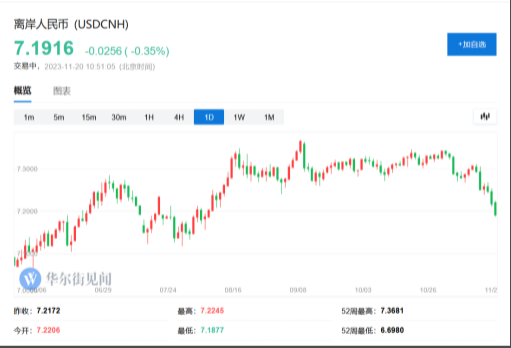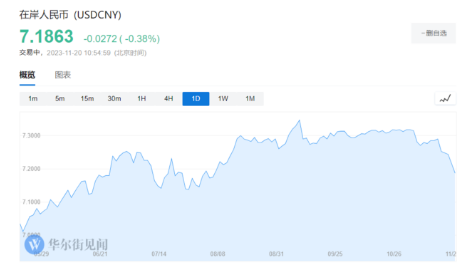您们的需要 我们的专注
Your Needs Our Focus
财经快讯
280點!離岸人民幣漲破7.19關口
11月20日週一,人民幣突現狂歡。
離岸人民幣兌美元持續走高,升破7.19關口,日內漲逾280點。在岸人民幣也在不斷走高。


稍早前,中國外匯交易中心數據顯示,人民幣兌美元中間價上調116點至7.1612,創8月以來最高紀錄。
國金證券認為,美元的快速走弱是人民幣匯率升值的直接推手。美元指數自10月下旬以來大幅回落,正在逼近100大關。

而美元回落,是美債供給側衝擊邊際緩和、經濟數據走弱、投機擾動緩和三方面因素共同作用的結果。國金證券在報告中寫道:
第一,美債供給側衝擊邊際緩和;四季度再融資會議上,財政部預計淨發債規模降至7760億美元、較7月預期值下降760億美元。
第二,經濟數據走弱、美聯儲態度偏鴿;11月陸續公佈的PMI、非農、CPI等數據均低於市場預期,市場對明年降息的預期逐步升溫。
第三,投機擾動也有緩和,美債非商業空頭持倉明顯回落。
國君證券認為,人民幣升值的背後,除了有美聯儲加息週期結束預期的外部因素支撐,還有有中間價的功勞,中間價作為匯市“穩定器”,在做空離岸人民幣成本下降的背景下,對人民幣形成強勁支撐。
國君宏觀周浩、孫英超在上周公佈的研報中指出,
離岸人民幣的融資成本開始明顯走低,這意味著做空人民幣的成本也同步下滑,但離岸人民幣並沒有出現部分投資者擔憂的貶值,反而借著近期的美元走弱出現了一波強力的升值。
中間價扮演了“穩定器”的作用,由於人民幣兌美元的中間價一直相對穩定,空頭仍然對政策意圖較為忌憚,沒有輕易在這一區域下注,而是希望等待更加清晰的信號。

也有分析認為,中間價調升或顯示出監管層對近期弱勢美元下人民幣即期出現的反彈予以確認。截止上周五時,境內外人民幣本月累計漲幅分別達約1.4%和1.7%。10月份時在岸人民幣持續運行在日內波動區間2%的貶值下限附近,週一在岸較中間價最大偏弱幅度縮窄至僅約0.65%。
“央行可能樂見境內外即期與中間價在今年底之前、尤其是美元下一波反彈之前實現三價合一,”外匯與利率策略師趙志軒在媒體採訪中說,中間價終於脫離9月以來在7.17附近的平臺區域,明顯是希望利用美國數據不達預期後美元走弱的時間窗口,在年底前推動人民幣升至7元一線。
風險提示及免責條款
市場有風險,投資需謹慎。本文不構成個人投資建議,也未考慮到個別用戶特殊的投資目標、財務狀況或需要。用戶應考慮本文中的任何意見、觀點或結論是否符合其特定狀況。據此投資,責任自負。

